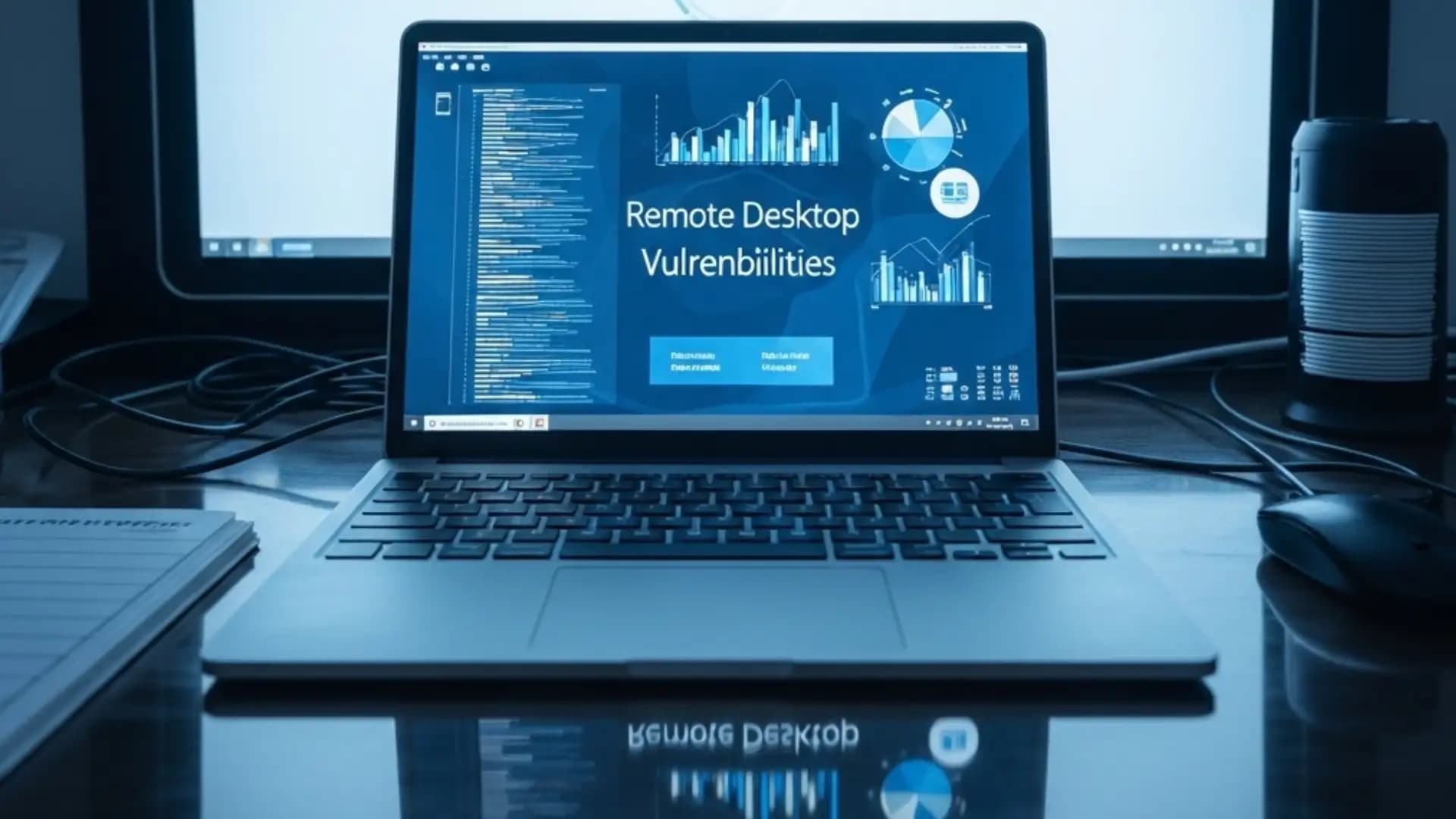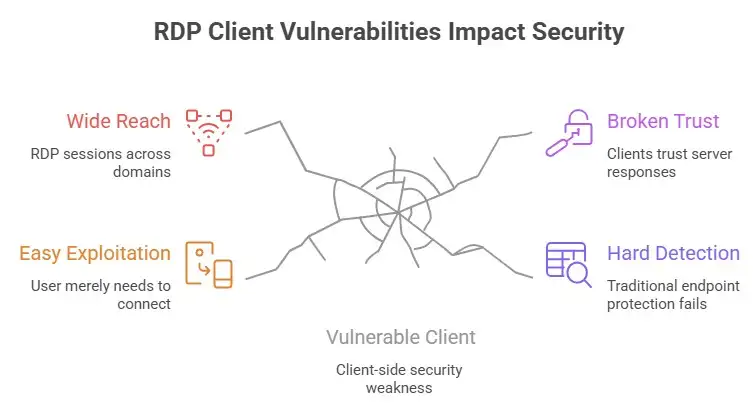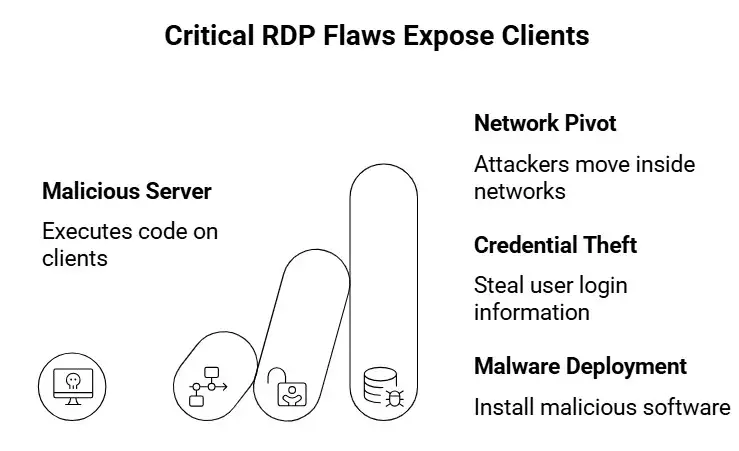Remote Desktop Vulnerabilities 2025: Windows RDP Code Risk

Hoplon InfoSec
15 Oct, 2025
Like drives or mapped directories. But the validation isn't robust enough, so a rogue server can construct routes that "escape" the directory boundaries that are allowed and fool the client into reading or writing files that aren't in that scope. Attackers can run whatever code they want on the client's PC via remote code execution.
It's even worse since the attack doesn't need high-level access on a lot of versions of Windows. A user who connects to a faulty RDP endpoint can trigger the problem.
Attackers are now targeting the RDP client space because of problems like remote desktop vulnerability 2025. They wish to join business networks.
What makes Remote Desktop Vulnerabilities 2025 dangerous?
You might be wondering, "Isn't RDP an issue on the server side, not the client side?" But a lot of RDP talks are about problems with servers. In 2025, we found out that the RDP client software is also a target for attacks. Connecting to an attacker is an act of self-compromise if a client has a security weakness that lets remote code run.
That is bad for a defender for a number of reasons:
• Not much interaction is needed: The user merely needs to connect. They don't have to click on a malicious link or open a file.
• Wide reach: A lot of companies let RDP sessions happen between cloud VMs, branch offices, or even separate domains. A failed RDP endpoint could be able to wait outside for connections.
• The assumption that trust is broken: Clients normally trust the server responses because they think they come from servers that are safe and well-managed. But a compromised or malicious server can utilize that trust to let someone else run code on your machine from a distance.
• Hard to find: Traditional endpoint protection is more about keeping attackers out than keeping client-side code execution secure from server answers.
In short, remote desktop vulnerabilities in 2025 create a new region where even vigilant users can be lured to connect to a rogue endpoint and get hacked.

A closer look into CVE-2025-48817 and how to use RDP Client
Let's look into what scientists have found out about CVE-2025-48817. The problem has to do with how the RDP client handles directory paths or file identifiers that the server sends. Hackers can utilize relative path traversal because the client doesn't examine closely enough.
If you connect to the bad server, it could send you a folder mapping or file resource with paths like ..\..\some\evil.exe. The attacker can make the client put or run code outside of the designated directory because the client doesn't clear or reject the files effectively. This enables programs to run from a distance while the user is logged in.
Microsoft gave this vulnerability a CVSS score of 8.8, which is very bad.
The remedy came out on July 8, 2025, with updates like KB5062553 and KB5062552.
The disturbing (and interesting) element is that neither the server nor the user needs to confirm this problem. All the attacker requires is for a user to connect. That shows how much harder it is to find remote desktop vulnerabilities in 2025.
RDP will have more difficulties in 2025, such as corrupted heaps and buffer overflows.
RDP has more than simply CVE-2025-48817 as a major issue in 2025. There are more things in the world. There are a lot of additional remote desktop vulnerabilities in 2025 that have to do with buffer overflows or heap corruption in the way the RDP client handles pictures and bitmaps.
Microsoft addressed CVE-2025-29966 and CVE-2025-29967 on Patch Tuesday in May 2025. These were both buffer overflow problems that broke the client's bitmap compression method. A poor RDP server or man-in-the-middle gateway can deliver a bitmap update that is excessively huge and fills up memory. This enables it to run any code it wants.
CVE-2025-26645 is a different kind of relative path traversal than 48817, although it works in a similar way.
The April 2025 security update from Microsoft also notes that Remote Desktop Client contains a heap-based buffer overflow (CVE-2025-27487) that enables an authorized attacker to run code from a distance
. All of these are examples of remote desktop vulnerabilities in 2025, and the RDP client module is a frequent mechanism to exploit them.
What Attack Vectors Are and How to Use Them
Let me show you some ways to use it to make it more lifelike.
Scenario A: A faulty RDP server trap
A hacker makes a phony RDP server that seems authentic, like one that lets you access internal tools or enables you to be an admin from a distance. Someone connects to their company's server, assuming it's safe. The server sends back either changed route data or bitmap data that allows programming to operate on a system that is not connected to the server. The attacker can now run code on the client.
Scenario B: A hacked gateway or an attack in the middle of the network
An organization has had its RDP Gateway hacked or had a man-in-the-middle inserted in the way. The bad node adds exploits (bitmap overflow or path traversal) to the stream as clients connect through the gateway, rendering the client susceptible without their awareness.
Scenario C: Moving to the Side in the Network
If an attacker can get into one of the clients' computers, they might use it as a base. Then they exploit domain passwords or malware to obtain greater authority and go to other systems or resources. Because the first breach occurs on the client side through RDP, defenders can blame the wrong individual or miss the underlying source of the problem.
These examples highlight how weak points in remote desktops In 2025, these two things could work together to make greater attacks.That's what makes things riskier.
There are genuine weaknesses, not simply notions. A lot of hackers are trying to find RDP endpoints. For instance, GreyNoise data from August 2025 showed that about 2,000 malicious IPs were trying to access Microsoft RD Web Access and RDP Web Client endpoints at the same time.
In October 2025, researchers uncovered a botnet with more than 100,000 IPs that was employing timing and login enumeration to attack U.S. RDP services. Hackers utilize these scans to discover genuine workstations, look for weak passwords, and be ready to take advantage of RDP weaknesses.
It portrays a grim picture: attackers are already seeking for holes in huge numbers before a new one is fully published. That highlights how important it is to fix and make defenses better.
Honeypot testing like HoneyWin also showed that RDP is one of the most abused protocols. Hundreds of people try to log in every day, and one method they use to do it is through remote desktop sessions.
You can't wait because Remote Desktop 2025 and active scanning campaigns have problems. Attackers already know how to get in.

Problems with Finding and Defending
It may not seem like it would be hard to safeguard against these RDP vulnerabilities on the client side, but it is.
Here are some issues:
• Things that typical EDR doesn't see: Many endpoint detection systems think that attacks are happening (bad connections to a computer). But in this scenario, the assault comes from the client module itself while an actual connection is being made. Behaviors may seem "normal" at first.
• Scanning gives false negatives: Most of the time, security scanners seek for weak settings and open port 3389 on servers that use RDP. They might not say anything about the client's RDP client module versions or route traversal issues. A lot of businesses have more than one version of Windows on their computers, servers, and virtual machines. It's not easy to keep all the pieces of the RDP client up to date.
• What users do: Some users connect to endpoints they don't know, such as contractors, or remote access from hosts they don't know. It's easy to urge people to only trust RDP servers that are well-known, but it's hard to get them to do so.
• Attack chaining: Once attackers have code to run, they can turn off defenses, boost their privileges, or hide their tracks, which makes it hard to discover them quickly.
To protect remote desktop vulnerabilities in 2025, they need more than simply updates.
Best Ways to Lower Risk and Best Practices
Here are some useful things you should do
1. Fix it straight away:
Fix CVE-2025-48817 (RDP client), CVE-2025-29966/29967, CVE-2025-27487, and other RDP problems that are like these. Microsoft has already sent out patches.
2. Set limits on RDP endpoints that are allowed: Use a VPN or firewall restrictions to limit clients to only being able to connect to a small number of approved RDP servers. Don't let users connect to unknown endpoints by random or direct RDP.
3. Enable Network Level Authentication (NLA): This needs to be done before a full RDP session can be set up. This makes it tougher for attackers to get in without being verified.
4. Watch for weird patterns: Set up alerts for RDP connections to unfamiliar endpoints, recurrent session failures, or strange bitmap traffic patterns that could signal someone is trying to take advantage of something.
5. Use Jump Hosts or Bastions: Instead of allowing clients to connect directly, set up a controlled gateway or jump host that checks and filters RDP traffic. This middleman can fix or clean things up before they go to the buyer.
6. Rules and training for users: Tell users to only connect to RDP servers that they trust and know. There is more than one way to log in. If someone invites you to connect to an endpoint you don't know, be careful.
7. Endpoint Hardening: Use application whitelisting, give accounts the least amount of privileges, and keep an eye out for unexpected child process execution that could happen because of code injection.
8. Network segmentation and egress controls: Only let clients make outward RDP connections when they actually need to. You can stop a hacked client from readily getting to vital servers by segregating networks.
9. Threat hunting and red teaming: Every so often, set up phony RDP servers in your environment to see how effectively clients and detection systems operate. Find risks that are hard to see by using a red team or internal threat hunting.
Putting these precautions in the "Mitigation" section of your content makes it more than just a description; it gives people something to do.
What we learned from things that happened in the past and stories
I want this to look more like a person. Think of a tiny business where everyone works from home. Sarah, the IT manager, made sure that the credentials were safe, fixed all the servers, and switched off the ports. But one contractor's laptop had an obsolete version of the RDP client.
That contractor used an RDP server from a third party to talk to a partner. They didn't know it, but the exploit was already on the server. Within minutes, spyware was operating on the contractor's laptop, delivering login details and ransomware into the network. Most defenders don't think about this very often, yet the breach started with a problem with the RDP on the client side.
In another scenario, a red team set up a fake RDP server in a pen test lab.
People that knew a lot about technology still connected and had a payload inserted into their session environment. That drives home the point: even specialists can make mistakes.
These instances indicate that the problems with remote desktops in 2025 are not just thoughts; they happen in real life.
Things to Watch Out for in RDP Security in the Future
• More RDP vulnerabilities on the client side: As server defenses get better, attackers will start to look for holes in RDP modules on the client side, such as route traversal, picture parsing, or data deserialization.
• Use of zero trust: More and more companies will switch to zero trust models. This means that they will see any remote endpoint, even client PCs, as a threat unless they are confirmed.
• Behavioral analytics and AI detection: To uncover covert RDP attacks, defenses will employ traffic modeling (such as unexpected bitmap sizes or path alterations) instead of matching signatures.
• Better working with virtualization and the cloud As more PCs and servers go to the cloud, RDP will operate with virtual desktop infrastructure. This might put all the tenants at risk.
• Use chaining and supply chain risk: Attackers could link RDP client RCE to other local weaknesses and travel around networks.
If defenders don't adjust, remote desktop vulnerabilities in 2025 could be a problem for a long time.
The end and a call to action
Right now, the "client" side of remote desktop protocol isn't safe by default either. The Windows Remote Desktop Client Vulnerability found in 2025 (CVE-2025-48817) demonstrates a change: hackers now exploit the server side of RDP to access clients. That alters how we think about threats.
If you haven't previously, check and fix all of your RDP clients. Limit the number of endpoints that your users can connect to. Watch out for RDP traffic that doesn't appear right. Most importantly, be careful: not every "remote server" is safe.
Do something straight away, before someone can get into your secure remote connection.
The Hoplon Insight Box
Here are some basic strategic tips for security teams:
• Your main priority should be to address CVE-2025-48817, CVE-2025-29966/29967, CVE-2025-27487, and other RDP client bugs.
• Only let connections to RDP endpoints that are very tightly monitored.
• Use NLA, multifactor authentication, and filtering to get out of the network.
• Build a bastion or leap box to manage RDP sessions.
• Look for bitmap patterns that don't make sense, route traversal behavior, or RDP connections that go out.
• Test how well RDP clients can protect themselves by using red teaming or threat hacking.
• Teach users about the risks of RDP and tell them they can only connect to servers they know.
• Plan ahead for safeguards like zero trust, behavioral detection, and breaking up the network.
Follow us on X (Twitter) and LinkedIn for more cybersecurity news and updates. Stay connected on YouTube, Facebook, and Instagram as well. At Hoplon Infosec, we’re committed to securing your digital world.
Share this :